The future is green and electrical. The industry is already using considerable amounts of electrical power, and the consumption is expected to increase even further in the future. Electric cars must be charged at home, at the cabin or at designated charging spots. Several new power sources are added to the grid, both large and small wind farms, distributed power-sources, such as roof-mounted solar systems and small-scale hydropower. At the same time, parts of the grid are old and poorly adapted to future use. AI@SINTEF has researchers with cutting-edge expertise in artificial intelligence and can help solve the challenges that the green shift brings.
Plan the right power production with AI
Balancing supply and demand of power is fundamental for a well-functioning power system and power market. There needs to be instantaneous balance in the system at all times. To ensure access to power when we need it, suppliers must plan production based on anticipated total demand and the associated market price.
Today, complex mathematical models are used to predict both consumption and production. These models require significant computational power as they need to explore a huge number of potential scenarios. The predictions are not fully accurate and production therefore has to be adjusted in real time. This is a demanding task as the market is affected by continuous changes in production and consumption throughout Europe.
Using models based on machine learning, which is a method in artificial intelligence, computation time can be reduced for short-term planning such that decision support can be provided at the right time.
Take advantage of the flexibility in hydropower
The price of electricity varies throughout the day and between the seasons. This is decided by both the weather (precipitation, sun, wind and temperature) and the need for electricity.
Hydropower is often referred to as a green battery, a power source that can be easily regulated to balance the variation in demand and in other renewable energy sources, such as solar and wind. Power producers can save water when it is windy and the sun is shining, and then produce more power from the water when the other renewable sources are unavailable, or when the price is high.
Through computer models and machine learning, we can improve production planning and get more value out of the water in the reservoirs. We can also use data from previous years and long-term forecasts to include seasonal variations in models used for decision support.
SINTEF uses the AI method reinforcement learning to find connections between water value, power price and inflow in historical data. At the same time, the model continuously learns from new data and thus can adapt to climate change and market development. Combined with traditional methods, artificial intelligence becomes a powerful tool for long-term production planning.
Get the best possible maintenance for the lowest possible price
Maintenance of transmission and distribution grids and production equipment should be planned for periods when the consequence of the unit being taken out of operation is as low as possible. At the same time, maintenance must be performed before the condition becomes critical. This can best be done using optimization algorithms.
In addition, we want a better overview of the condition of the equipment to do maintenance when it is necessary. Condition monitoring and anomaly detection can identify abnormal conditions such as wear and tear, as well as misconfiguration and help facilitate predictive maintenance.
SINTEF applies data-driven methods within the field of predictive maintenance to create insight and help make the best decisions.
Affordable and predictable network operation
The power grid is experiencing increasing loads, and parts of the grid are aging. Upgrading the grid to meet future needs is costly and may be controversial. Hence, the grid companies want to optimally utilize the grid that already exists and postpone or avoid building new lines.
Optimization algorithms combined with machine learning could help, for example by finding the optimal balance between network utilization and risk of outages. Such optimization algorithms may generally be used to optimize delivery reliability. SINTEF is working on this in the RaPid project.

